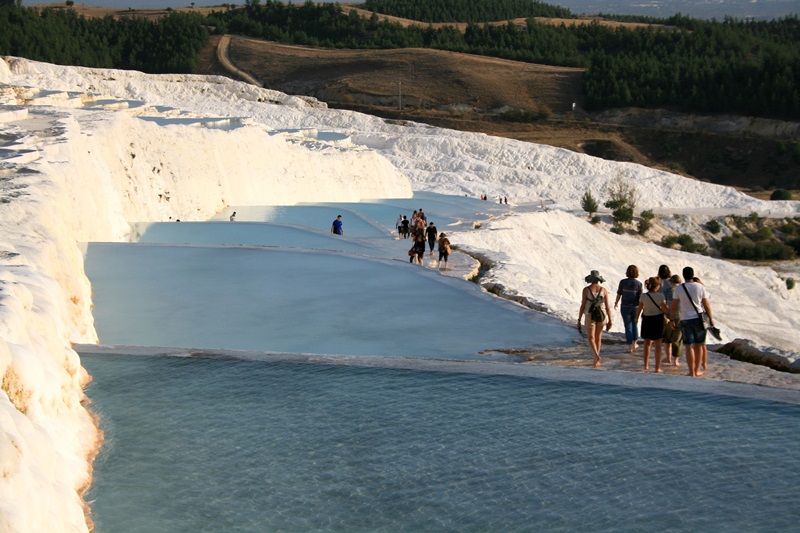


PAMUKKALE
Pamukkale, meaning “cotton castle” in Turkish, is a natural site in Denizli Province in southwestern Turkey.

The city contains hot springs and travertines, terraces of carbonate minerals left by the flowing water. It is located in Turkey’s Inner Aegean region, in the River Menderes valley, which has a temperate climate for most of the year.

The ancient Greco-Roman and Byzantine city of Hierapolis was built on top of the white “castle” which is in total about 2,700 metres (8,860 ft) long, 600 m (1,970 ft) wide and 160 m (525 ft) high.

It can be seen from the hills on the opposite side of the valley in the town of Denizli, 20 km away.

Tourism is and has been a major industry. People have bathed in its pools for thousands of years. As recently as the mid-20th century, hotels were built over the ruins of Hierapolis, causing considerable damage. An approach road was built from the valley over the terraces, and motor bikes were allowed to go up and down the slopes. When the area was declared a World Heritage Site, the hotels were demolished and the road removed and replaced with artificial pools.

Wearing shoes in the water is prohibited to protect the deposits.
Pamukkale is a tourist attraction. It is recognized as a World Heritage Site together with Hierapolis. Hierapolis-Pamukkale was made a World Heritage Site in 1988.
 The underground volcanic activity which causes the hot springs also forced carbon dioxide into a cave, which was called the Plutonium meaning place of the god, Pluto. This cave was used for religious purposes by priests of Cybele, who found ways to appear immune to the suffocating gas.
The underground volcanic activity which causes the hot springs also forced carbon dioxide into a cave, which was called the Plutonium meaning place of the god, Pluto. This cave was used for religious purposes by priests of Cybele, who found ways to appear immune to the suffocating gas.
 Travertine is a form of limestone deposited by mineral springs, especially hot springs. Travertine often has a fibrous or concentric appearance and exists in white, tan, cream-colored, and even rusty varieties.
Travertine is a form of limestone deposited by mineral springs, especially hot springs. Travertine often has a fibrous or concentric appearance and exists in white, tan, cream-colored, and even rusty varieties.
 It is formed by a process of rapid precipitation of calcium carbonate, often at the mouth of a hot spring or in a limestone cave. In the latter, it can form stalactites, stalagmites, and other speleothems. It is frequently used in Italy and elsewhere as a building material
It is formed by a process of rapid precipitation of calcium carbonate, often at the mouth of a hot spring or in a limestone cave. In the latter, it can form stalactites, stalagmites, and other speleothems. It is frequently used in Italy and elsewhere as a building material
Red Springs
 Karahayit Red Springs is located approx 8 kms from Pamukkale
Karahayit Red Springs is located approx 8 kms from Pamukkale
EGIRDIR
 Eğirdir is a town and district of Isparta Province in the Mediterranean region of Turkey.
Eğirdir is a town and district of Isparta Province in the Mediterranean region of Turkey.
 The town and the lake were formerly called Eğridir, a Turkish pronunciation of the town’s old Greek name Akrotiri.
The town and the lake were formerly called Eğridir, a Turkish pronunciation of the town’s old Greek name Akrotiri.
 However, Eğridir means “it is crooked” in Turkish, and therefore, to remove the negative connotations of the name, in the 1980s the “i” and the “r” were transposed in a new official name, thus creating Eğirdir, a name that evokes spinning and flowers, although many people in Turkey still call both the town and the nearby Lake Eğirdir by its former name.
However, Eğridir means “it is crooked” in Turkish, and therefore, to remove the negative connotations of the name, in the 1980s the “i” and the “r” were transposed in a new official name, thus creating Eğirdir, a name that evokes spinning and flowers, although many people in Turkey still call both the town and the nearby Lake Eğirdir by its former name.
text taken from wikipedia






What an amazing place. Thanks for a great article 🙂